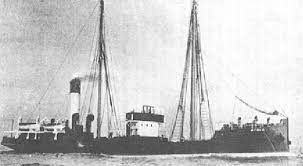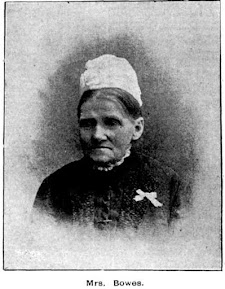A tragedy at sea
Islands attract ships and
some of those ships are lost. There have been many shipwrecks in the seas
surrounding Australia and today's blog relates to one of New South Wales' worst
peace time maritime disasters – during a terrible year of such disasters - with
a link to Rookwood.
THE KEILAWARRA DISASTER OF
1886
In December 1886 the 784-ton
steamship the Keilawarra, built in Scotland eight years prior, was heading from
Sydney to Brisbane loaded with food stocks, casks of various alcoholic
beverages, tobacco, paint and special cargo including two bulls and a heifer, a
box of bees and two racing horses. There were also passengers and crew totalling
about 80 under the command of Captain Buttrey, a man with some twenty years' service with the Australian Seam Navigation Company. Heading in the other
direction was the smaller steamer the Helen Nicoll under the direction of
Captain Fraser carrying far fewer passengers and crew.
As the Keilawarra steamed
north all went well until near Coffs Harbour in the vicinity of the North
Solitary Islands on the night of 8th December 1886.
In the darkness, the smoke
from the funnel of the Helen Nicoll obscured the view northbound. A light emitted
from that vessel, and it was assumed at first that the larger vessel had seen
the Helen Nicoll. As the Keilawarra headed at speed straight toward the smaller
vessel, the Captain of the Helen Nicoll finally sounded a warning blast from
the whistle, turned his smaller steam ship towards the open sea and ordered the
engines "slowed" then put into reverse. His actions actually drove
the Keilawarra across the smaller ship’s bow. The impact was horrendous with
the side of the Keilawarra sliced open, pushing the vessel momentarily on its
side with both steamers entwined.
With the bow shattered many
aboard the Helen Nicoll jumped onto the deck of the larger Keilawarra believing
that the smaller vessel would sink. Four of the eleven people who leaped overboard
drowned. The Keilawarra's bow went underwater and many rushed for the port
boat with chaotic scenes with many men beating off women and children for a
seat upon it. Others were seen to leap overboard with lifebelts.
The Keilawarra rose almost
vertically, its propeller broke the surface and then plunged into the sea. It
took all of seven minutes.
Captain Buttrey went down
with his ship, after earlier refusing a lifebelt which he gave to a female
passenger. Much debris from the steamer littered the surface of the sea and
together with the darkness made it difficult for boats from the Helen Nicoll to
find survivors.
Captain Buttrey of the Keilawarra - NSW Department of Environment with thanks
The captain managed to steer
the Helen Nicoll into nearby Trial Bay and the survivors were transferred to
another ship sailing to Sydney. Upon arrival there were scenes of jubilation as
well as despair. Only two bodies and two of the Keilawarra's lifeboats were ever
located ashore.
Helen Nicoll after the collision - State Library of NSW with thanks
Mrs. Alice Wilson was the
only adult woman on the Keilawarra to Survive. Waves had knocked her and her
husband overboard. She attempted to hold on to her injured spouse but had to
let him go and he drowned. She managed to reach a floating box. The only child
who survived was 12-year-old Alice Cornwell. She was washed overboard but
managed to cling to a bag of chaff intended for the horses. The worst family
loss was Mr. Schepper, his wife and six children, last seen clinging together. The
only lifeboat successfully launched contained about twenty men with a least
another five clinging to its side.
In the old Presbyterian
section of the cemetery there is a tablet on the family monument commemorating
Major John Macdonald a highly respected resident of the inner Sydney suburb of
Balmain. Major Macdonald was one of the Highland Society and had recently been
one of the promoters of the newly formed Sydney Scottish Rifles. The first NSW
Military Unit with a Scottish Association was The Duke of Edinburgh's Highlanders
formed in 1868. The Unit became known as the Highland Brigade before it was
disbanded in 1878. After the death of General Gordon in Khartoum in 1885, the
NSW Government sent a special force to the Sudan which led to the formation of
a new unit called the Scottish Volunteer Rifle Corps, later abbreviated to the
Scottish Rifles and first paraded in November of that year. John Macdonald left
a widow to mourn his loss, as well as a host of friends with added sorrow due
to the circumstances surrounding his death. All stated that the Major would
have shown great strength of character to the very end.
Major John Macdonald tablet on family monument - author's own
His tablet states:-
In Memoriam, John Macdonald, eldest son of the abovenamed who was drowned on the floundering of a steamship on 8th December 1886. Etat 54
An affectionate husband, a dutiful son and brother. A true friend and an earnest Christian. Loved most by those who knew him best.
The Marine Board held an
inquiry into the disaster and blamed Captain Buttrey for "recklessly
navigating his vessel" in not slowing when lights had been seen ahead and
for cutting across the Helen Nicoll's path. The court also severely censured Mr.
Knowles, First Mate of the Helen Nicoll for proceeding at full speed.
Research shows that 37 drowned
from the Keilawarra (14 crew and 24 passengers) together with 4 from the Helen Nicoll.
New regulations were
introduced for all coastal steamers to carry sufficient lifebelts for every
person aboard, specifically stowed for easy release when needed.
The wreck of the Keilawarra
was found on 18 September 2000, located in 74 metres of water. The site was
found to have been plundered in 2010 of one of its safes contents, thought to
have occurred in 2007. None of the alleged plunder has come to light. The site
is protected under the Historic Shipwrecks Act.
The South Solitary Island
lighthouse was built in 1880 and designed by the Colonial Architect James
Barnet (who calls Rookwood "home") due to the number of serious
shipwrecks in the seas. At the inquest, following the disaster, it was
recommended that the Lighthouse have telegraphic communication with the
mainland, that the proposed Coffs Harbour Jetty be immediately constructed and
thirdly that a Coroner be appointed to the Coffs Harbour area.
Even with these
recommendations being taken up, there were still serious shipwrecks in the
area, the most recent being in 1950.
It seems that the sea is a
beast that will never be tamed.
May they all RIP
I have reference information
from the NSW Heritage Office, the NSW Environment, Energy and Science Department
and many newspaper reports gleaned from Trove a division of the National
Library.
If you have any comments
regarding this blog, please place them below or at the Facebook Group page which
you can find via a search of
rookwoodcemeterydiscoveries
or simply send me an email
at
lorainepunch@gmail.com
until next week








Sad story but the men that survived i consider cowards for their actions. But sadly it is still happening today. 😢
ReplyDeletePerhaps. Panic can mean all procedures may be forgotten.
Delete